
Apiaceae or Umbelliferae is a family of mostly aromatic flowering plants named after the type genus Apium and commonly known as the celery, carrot or parsley family, or simply as umbellifers. It is the 16th-largest family of flowering plants, with more than 3,800 species in about 446 genera, including such well-known and economically important plants as ajwain, angelica, anise, asafoetida, caraway, carrot, celery, chervil, coriander, cumin, dill, fennel, lovage, cow parsley, parsley, parsnip and sea holly, as well as silphium, a plant whose exact identity is unclear and which may be extinct.
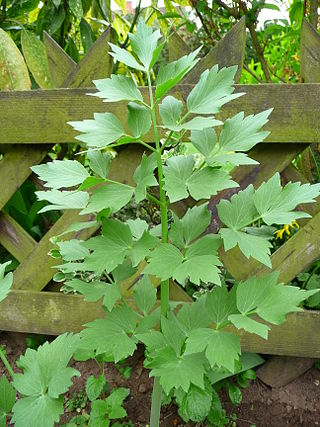
Lovage, Levisticum officinale, is a tall perennial plant, the sole species in the genus Levisticum in the family Apiaceae, subfamily Apioideae. It has been long cultivated in Europe, the leaves used as a herb, the roots as a vegetable, and the seeds as a spice, especially in southern European cuisine. Its flavour and smell are reminiscent both of celery and parsley, only more intense and spicy than either. The seeds can be used in the same way as fennel seeds.
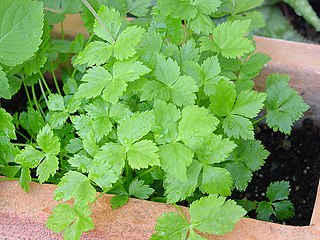
Cryptotaenia, or honewort, is a genus of herbaceous perennial plants, native to North America, Africa, and eastern Asia, growing wild in moist, shady places.

Erigenia bulbosa, also known as harbinger of spring or pepper and salt, is a flowering perennial plant in the family Apiaceae. E. bulbosa is the only species in the genus Erigenia and tribe Erigenieae. This plant is known as harbinger of spring because it is one of the earliest blooming native wildflowers of rich forests in the mid-latitude United States. Throughout most of its range it blooms from late February through early April.

Helosciadium bermejoi, synonym Apium bermejoi, is a critically endangered species of flowering plant in the family Apiaceae.
Sium burchellii, known commonly as dwarf jellico, is a species of flowering plant in the family Apiaceae. It is endemic to Saint Helena. It grows on steep island cliffs. It is threatened by the fragmentation of its small populations, introduced species of plants, landslides, and possibly hybridization with Sium bracteatum.

Sium is a genus of flowering plants in the family Apiaceae. It is widely distributed across Europe, Asia, Africa, and North America. Plants of this genus are commonly called water parsnips.
Sium bracteatum is a species of flowering plant in the family Apiaceae. It is endemic to Saint Helena. It is protected in Diana's Peak National Park, but proper management practices have not yet been established. It is threatened by fragmentation of its populations, introduced species of plants, and possibly hybridization with Sium burchellii.
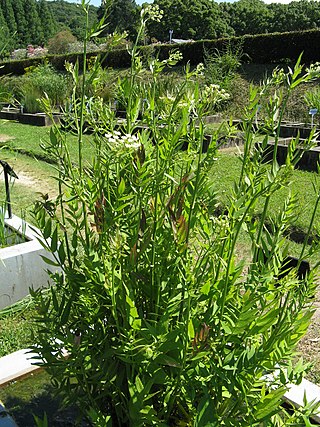
Sium suave, the water parsnip or hemlock waterparsnip, is a perennial wildflower in the family Apiaceae. It is native to many areas of both Asia and North America. The common name water parsnip is due to its similarity to parsnip and its wetland habitat. The alternate common name hemlock waterparsnip is due to its similarity to the highly poisonous spotted water hemlock.
Water parsnip is a common name given to a number of flowering plants in the family Apiaceae, including those from the Berula and Sium genera.

Berula erecta, known as lesser water-parsnip, cutleaf waterparsnip, or narrow-leaved water-parsnip, is a member of the carrot family. Growing to around 1 m (3 ft) tall, it is found in or by water. It is widespread across much of Europe, Asia, Australia, and North America.

Angelica capitellata, synonym Sphenosciadium capitellatum, is a species of flowering plant in the family Apiaceae. When treated as Sphenosciadium capitellatum, it was the only species in the monotypic genus Sphenosciadium. It is known by the common names woollyhead parsnip, ranger's buttons, button parsley, and swamp white heads.

Helosciadium nodiflorum, fool's watercress, is a flowering plant found in ditches or streams, as well as fresh and brackish-water wetlands native to western Europe. It is not poisonous to humans but it could be easily confused with the allegedly poisonous lesser water parsnip.

Epermenia chaerophyllella, also known as the garden lance-wing, is a moth of the family Epermeniidae first described by Johann August Ephraim Goeze in 1783. It is found in all of Europe and Asia Minor.
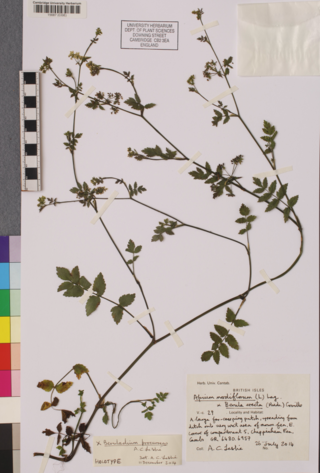
× Beruladium procurrens is an intergeneric hybrid plant in the umbellifer family (Apiaceae); the result of hybridisation between Berula erecta and Helosciadium nodiflorum.
Glaucosciadium is a genus of flowering plants belonging to the family Apiaceae.
Kozlovia is a genus of flowering plants belonging to the family Apiaceae.
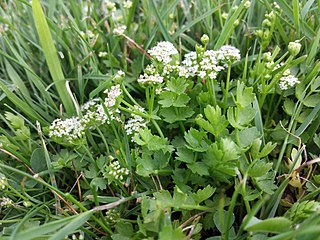
Helosciadium repens commonly known as creeping marshwort, is a species of plant belonging to the Apiaceae family. It occurs in Western and Central Europe, being rare throughout its range. It grows in wetland areas where it does not have to compete with taller plants due to grazing by animals, periodic flooding during the winter-spring seasons, or mowing. It is considered a species of near-threatened status at the continental level, critically endangered and legally protected in Poland. It is subject to protection within the European Natura 2000 network.













